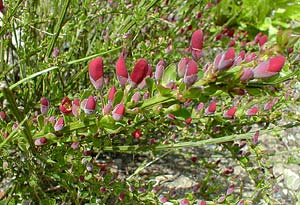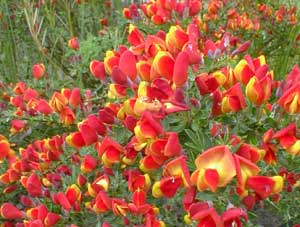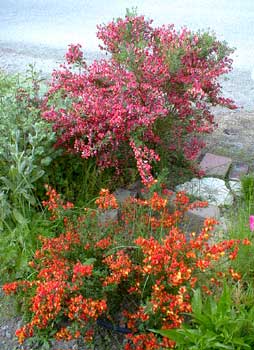
Lena's Broom
"When the pods went pop
on the broom, green broom
And apples began to
be golden-skinned
We harboured a stag
in the Priory coomb
And we feathered his
tail upwind, upwind."
-John Davidson
1857-1909
1857-1909
This hybrid broom is Cytisus scoparius x dallimorei 'Lena' named after the German hybridizer.
 Herr Lena's other classic broom varieties include 'Firefly,' 'Golden Sunlight,' 'Red Wings,' 'Luna,' 'Palette,' 'Goldfinch,' & another that's in our garden, "Burkwoodii." The third photo below shows 'Lena' in front of 'Burkwoodii' in full flower together in May.
Herr Lena's other classic broom varieties include 'Firefly,' 'Golden Sunlight,' 'Red Wings,' 'Luna,' 'Palette,' 'Goldfinch,' & another that's in our garden, "Burkwoodii." The third photo below shows 'Lena' in front of 'Burkwoodii' in full flower together in May.Lena's Broom is a recipient of the Award of Garden Merit from the Royal Horticultural Society. It should by no means be mistaken for the wild yellow broom that is an invasive pest, as 'Lena' is a well-behaved desirable shrub.
Our specimen of Lena's Broom was a bit over two feet tall as of 2003, & had spread to a good three feet wide by 2004. The variety generally grows three or four feet high, occasionally larger, with equal width.
Though pruning is not necessary, I have lightly sheered 'Lena' less than once a year, & the little shrub seems to appreciate it.
 It is in full maroon bud by the end of the first week in May, as shown in the maroon bud portrait above. When these open well before April's end, the flowers are lemony-yellow to orange in the middle, with large brilliantly crimson ruby wings, as shown in the second (April 2004) photo. The flowers can are usually spent before May's end, but some years linger into the start of June.
It is in full maroon bud by the end of the first week in May, as shown in the maroon bud portrait above. When these open well before April's end, the flowers are lemony-yellow to orange in the middle, with large brilliantly crimson ruby wings, as shown in the second (April 2004) photo. The flowers can are usually spent before May's end, but some years linger into the start of June.We have besides Lena's Broom & two Burkwood's Brooms a much more slow growing Lilac Time Broom, all planted out by the roadside. They like full sun & temperate seasons, having originated in central & southern Europe.
They are in the main exceedingly adaptable. In chillier zone 6, it may suffer some winter damage, but with winter-burned limbs trimmed off in spring, it bounces back rapidly.
Broom cultivars prefer sandy harsh soils & very little water, so thrive on neglect, although of our three cultivars, 'Lilac Time' requires a little more attention than the others, needing water during droughty summers.
When they are finished blooming, they remain pleasing upright & rounded shrubs with thin stems & tiny green semi-deciduous leaves.
As brooms are of the legume family, they have pea-pods in summer. These are green at first, then dry & harden to brown. On a hot July day the pods will make quite a loud "snap" as they pop open & broadcast their seeds.
One option for its care is to trim it back as soon as it stops flowering, so that it will not produce so many of the pea-pods, but will instead expend its energy producing tightly compact shrub of the tiniest green leaves.